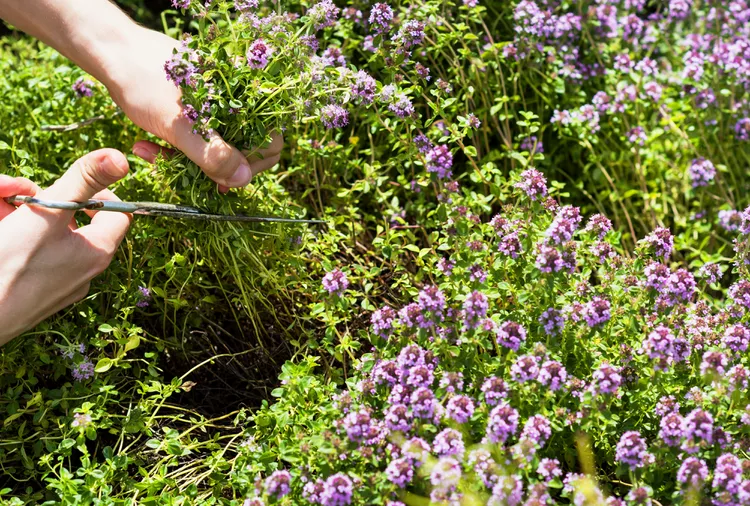How to Prune Thyme to Keep Your Herb More Productive

If you have just one thyme plant in a container, you may be harvesting enough to encourage plenty of fresh new growth–use it in garlic-thyme sauce or thyme-roasted chicken. But knowing how to prune thyme can help when your plant starts getting leggy or straggly. Keeping culinary thyme, and even creeping thyme varieties used as groundcover, in a neater shape will result in more fresh, tender growth and fewer bare, woody stems.
Reasons for Pruning Thyme
Prune culinary thyme when you want the plant to produce more vegetative growth with a bushy habit. Occasional pruning will help keep it from getting woody and sparse at the base. Gardeners also prune thyme to remove flowers so the plant remains in the growth stage (rather than reproductive), and for taking cuttings to propagate more thyme.
Encourage a bushy shape.
Thyme plants, even upright varieties, tend to be a bit sprawling and can look loose and carefree. But, that informal look often comes with straggly branching. Trimming the runaway stems will cause them to be bushy and vigorous. Older plants tend to get sparse and shrub-like at the base (and unattractive). A refresh in spring will help stems tender and pliable instead of woody.
When a stem is trimmed, the plant responds by sending out more branches from the nearest node. Thyme is a semi-woody herb, and pruning has the same effect as it would on woody shrubs like yew (Taxus spp.) or boxwood (Buxus spp.)–it forces more branching and a compact habit with more foliage.
Prevent thyme from flowering.
Thyme flowers are edible, and pollinators love them, but many gardeners prefer to keep their thyme in vegetative mode so that the plants continue making more tasty leaves. Thyme doesn't acquire a bitter taste after flowering like some other herbs. However, it can taste slightly mild, with a less potent flavor and aroma.
Once you've harvested all the thyme you'll want for the year, you may wish to let it flower and enjoy watching the bees go crazy for it. Thyme flowers are dainty and attractive, lending themselves well to homegrown bouquets of cut flowers.
Cuttings for thyme new plants.
Straight growing stems of this year's growth are excellent candidates for propagating with stem cuttings you can use to create more thyme plants. Here's how:
- Snip off a section containing a growing tip and about 4-6 inches of stem. Select a stem that is not flowering or hasn’t flowered yet.
- Do a final trim on the cutting just below a node, and gently strip the leaves off the bottom ⅔ of the stem.
- Gently poke it into moist potting soil (add a big handful of perlite or use seed-starting mix to boost drainage), and keep it moist by covering or misting regularly.
- Set them out of direct sunlight. In about 3-4 weeks, your thyme cuttings should be rooted.
When to Prune Thyme Plants
Thyme can be pruned or cut back several times yearly for mass harvesting or to control flowering, shaping, and gathering stem cuttings. Autumn is a good time for a general haircut pruning. Lighter pruning can be done at any time.
If you are pruning a small plant or only a few stems, take the extra moment to do it via the method below. If you have many plants or a large plant, it's okay to grab a handful and cut all at once, even if it isn't exactly at a node.
Steps for Pruning Thyme
Pruning thyme plants is a snap; it might be the most pleasant-smelling task you've ever done.
- Grab a stem and look for a node where leaves attach to the stem. There's usually a node on culinary thyme about every inch or so.
- Use your fingernails, herb snips, or scissors to pinch or snip the stems just above the node.
- Repeat for any stems that are flowering or to force more growth. Avoid removing more than ⅓ of the stem at a time or ⅓ of the entire plant at the same pruning.
If you're going to propagate some of the pruned thyme stems, keep them from drying out by immediately placing them in a sealed plastic bag with a damp paper towel until you can get them back to the house and potted up.
Care Tips for Thyme Plants
Pruning and frequent harvesting will keep your thyme in good shape, and providing it with the right amounts of water and light will help it produce the most flavorful leaves full of aromatic oils.
Watering
Once established, thyme is drought tolerant. In fact, this herb would rather grow on the dry side and suffers in consistently moist conditions. When growing in the ground, it seldom needs to be watered unless you are experiencing extremely dry weather.
Thyme grown in containers likely will need supplemental watering in between rain showers. Let the soil dry out a bit first. Test by sticking your finger in the potting soil and feeling for moisture. Wait to water until it feels dry up to the middle knuckle. Watering thoroughly but infrequently is better than many constant shallow waterings to encourage deeper roots.
Light
Thyme grows best in full sun. It loves dry, warm, sunny weather (like the Mediterranean) and will grow slowly and have less flavor in lower light. Thyme can be grown quite successfully indoors, but you'll need to provide a super-sunny window or bright artificial light to make it happy.